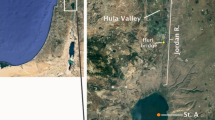Abstract:
Selenium is an essential micronutrient for the growth of the dinoflagellate Peridinium gatunense that dominates the spring algal bloom in Lake Kinneret (LK). The relationship between the levels of dissolved selenium species and the occurance of algal blooms in this lake was studied. During algal blooms of P. gatunense in spring and of the blue-green Aphanizomenon ovalisporum in fall (in 1994) the concentration of epilimnetic dissolved organic Se (Seorg) increased whereas that of selenite (SeIV) decreased, to levels below the limit of detection: 5ng/l. The disappearance of SeIV during these blooms is attributed to algal uptake and it is suggested that the growth of both algae may have depended on Seorg regeneration. A budget performed for selenate (SeVI) suggests that this species is also consumed by algae but to a lesser extent than SeIV (in 1994 ∼ 40 % of the epilimnetic load). During the stratification period the hypolimnion of Lake Kinneret becomes anoxic, with high levels of dissolved sulfide. The affects of this environment on the distribution of Se oxy-anions, selenite (SeIV) and selenate (SeVI), were also studied. At the onset of thermal stratification (March) about 35 % of the lake inventory of both Se oxidized species are entrapped in the hypolimnion. During stages of oxygen depletion and H2S accumulation, SeIV is completely and SeVI partially removed from this layer. The removal is attributed to reduction followed by formation of particulate reduced products, such as elemental selenium Se(o). The ratio between SeVI to total dissolved selenium (SeT) in water sources to the lake is ∼ 0.84, about twice the corresponding ratio in the lake (∼ 0.44, during holomixis). In the lake about 75 % of annual SeVI inflow from external sources undergoes reduction to selenide (Se-II) and Se(o) through epilimnetic algal assimilation and hypolimnetic anoxic reduction, respectively. It is suggested that the latter oxidation of the dissolved organic selenide released from biogenic particles and of Se(o) only to the tetravalent species is the cause for the lower ratio of SeVI/SeT in the lake.
Similar content being viewed by others
Author information
Authors and Affiliations
Additional information
Received 21 August 1998; revised manuscript accepted 9 March 1999.
Rights and permissions
About this article
Cite this article
Nishri, A., Brenner, I., Hall, G. et al. Temporal variations in dissolved selenium in Lake Kinneret (Israel). Aquat. sci. 61, 215–233 (1999). https://doi.org/10.1007/s000270050063
Issue Date:
DOI: https://doi.org/10.1007/s000270050063




